May 10, 2011
For a downloadable version, click the following:
Down the Rabbit Hole (and Through the Looking-glass): Where Employment Rises and Unemployment also Rises???
U.S. Department of Labor, Bureau of Labor Statistics
Friday, May 6, 2011
THE EMPLOYMENT SITUATION – APRIL 2011
Nonfarm payroll employment rose by 244,000 in April, and the unemployment rate edged up to 9.0 percent, the U.S. Bureau of Labor Statistics reported today.
How can this occur? The simple answer is that while the U.S. experienced job growth of 244,000 for the month according to the Current Employment Statistics or Establishment Payroll Survey, the larger more inclusive Current Population Survey (or Household Survey) told a different story. In the Current Population Survey, 190,000 people were dropped from the employment rolls and an additional 15,000 people entering the Labor Force were unable to find work, for a total of 205,000 people added to the unemployment statistics in April 2011 from the preceding month.
While the traditional Payroll Survey sector certainly added jobs, the overall employment picture, as captured in the more inclusive Household Survey, actually worsened.
Keep in mind that the Current Employment Statistics or Establishment Payroll Survey (http://bls.gov/ces/) focuses on larger, more traditional firms that report various statistics to the Department of Labor on a regular basis. Those statistics are used to track productivity, hours worked, etc, in addition to changes in employment. Many small businesses, self-employed and the like are not included in this survey. The Current Population Survey or Household Survey (http://bls.gov/cps/) includes the entire workforce, from the self-employed through employees at large corporations.
From the Bureau of Labor Statistics
Why are there two monthly measures of employment?
The household survey and establishment survey both produce sample-based estimates of employment and both have strengths and limitations. The establishment survey employment series has a smaller margin of error on the measurement of month-to-month change than the household survey because of its much larger sample size. An over-the-month employment change of about 100,000 is statistically significant in the establishment survey, while the threshold for a statistically significant change in the household survey is about 400,000. However, the household survey has a more expansive scope than the establishment survey because it includes the self-employed, unpaid family workers, agricultural workers, and private household workers, who are excluded by the establishment survey. The household survey also provides estimates of employment for demographic groups.
To read more about the differences between the two surveys…
Jobless Recovery - - - a bogus issue?
March 2004
www.econnewsletter.com/mar292004
UPDATE ON JOB GROWTH
Data extracted from Department of Labor, Bureau of Labor Statistics
May 8, 2011
Employment Situation – April 2011
(Latest monthly data)
Additional information about the household survey can be found at www.bls.gov/cps/documentation.htm
- Civilian Noninstitutional Population = 239,146,000
Persons not in the labor force combined with those in the civilian labor force constitute the civilian noninstitutional population 16 years and over. (There is no upper age limit.)
- Civilian Labor Force = 153,421,000
The civilian labor force is the sum of employed and unemployed persons. Those not classified as employed or unemployed are not in the labor force.
- Civilian Labor Force Participation Rate = 64.2%
(153, 406,000 divided by 239,000,000 = 64.2%)
The labor force participation rate is the labor force as a percent of the population, and the employment-population ratio is the employed as a percent of the population.
- Employed = 139,674,000
People are classified as employed if they did any work at all as paid employees during the reference week; worked in their own business, profession, or on their own farm; or worked without pay at least 15 hours in a family business or farm. People are also counted as employed if they were temporarily absent from their jobs because of illness, bad weather, vacation, labor-management disputes, or personal reasons.
- Unemployed = 13,747,000
Note: if the Labor Force Participation Rate was 66.2% for the years 2001-2008, this would increase the unemployed by 4,894,000, bringing the adjusted unemployed number to 18,641,000
People are classified as unemployed if they meet all of the following criteria: they had no employment during the reference week; they were available for work at that time; and they made specific efforts to find employment sometime during the 4-week period ending with the reference week. Persons laid-off from a job and expecting recall need not be looking for work to be counted as unemployed. The unemployment data derived from the household survey in no way depend upon the eligibility for or receipt of unemployment insurance benefits.
- Unemployment Rate = 9.0% (U-3)
Note: if the Labor Force Participation Rate was 66.2%, this would increase the unemployment rate by 3.2%, bringing the adjusted unemployed rate to 12.2%
The unemployment rate is the number unemployed as a percent of the labor force.
From January 2001 through December 2008, the Labor Force Participation Rate averaged 66.2%. From January 2009 through March 2011, the Labor Force Participation Rate averaged 65%.
Keying on the Average Labor Force Participation Rate from Jan 2001 through Dec 2008 = 66.2%
Overlaying the 66.2% on the Civilian Noninstitutional Population of 239,146,000 we arrive at a Civilian Labor Force of 158,315,000
The difference between the official Civilian Labor Force (based on 64.2% participation rate: 153,421,000) and the adjusted Civilian Labor Force (based on 66.2% participation rate of 158,315,000) = 4,894,000
Assuming a goal of 66.2% Labor Force Participation Rate and targeting the Unemployment Rate at 5.3% (both average rates for Jan 2001 – Dec 2008), 10.3 million jobs would have to be added immediately.
For further reading,
Is Full Employment No Longer A Realistic Goal for this Decade?
May 12, 2010
The U.S. Economy: It’s beginning to look a lot like Europe
May 2, 2010
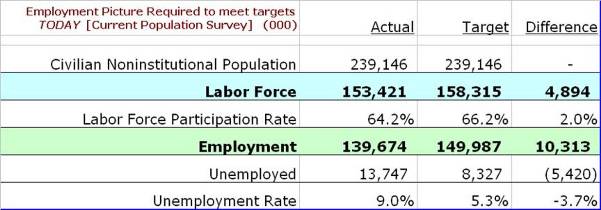
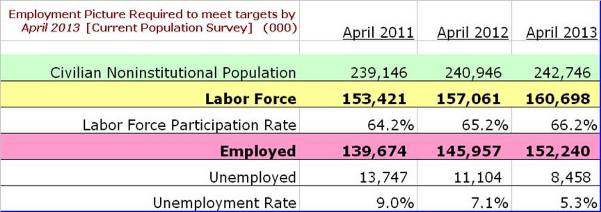

Keep in mind that the labor force adds new entrants every month so it will require around 150,000 new jobs to offset the growth in the labor force. In the two year period for example, there would have to be 524,000 monthly added into the Employment Rolls to, first, absorb the monthly influx of new entrants into the Civilian Noninstitutional Population (150,000), and secondly offset the 303,000 (once discourage, now encouraged) workers pouring back into the Labor Force. Finally, an additional 70,000 (or so) employees will have to be added to drive the unemployment rate down to the 5.3% range.
The total job creation required to lower the unemployment rate to 5.3 (assuming a 66.2 Labor Force Participation Rate) is on the order of 524,000 per month for two years!

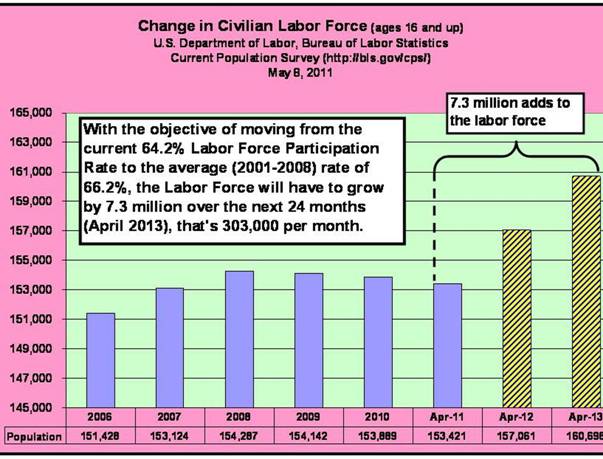
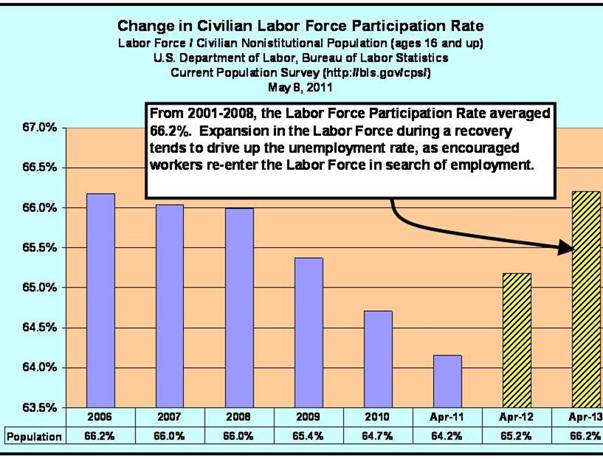
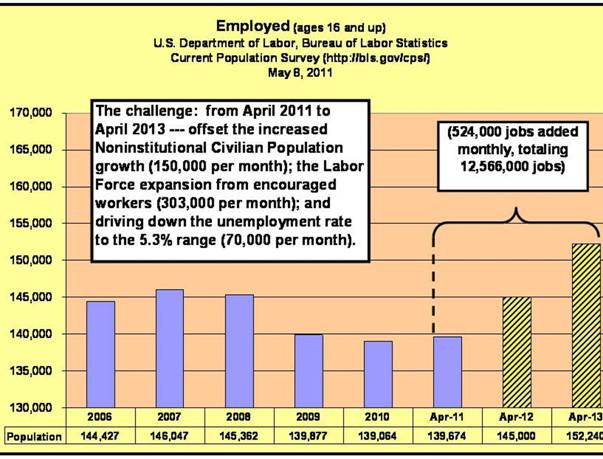
The preceding was discussed in greater detail in the following newsletter article. The difference just explained is due primarily to the enormous upward spike in the number of ‘discouraged workers’ and also includes the very discouraged workers who have opted for early retirement or permanent disability status, taking them out of the labor force calculation.
IF THE UNEMPLOYMENT RATE IS REALLY FALLING, WHY ARE SO MANY PEOPLE STILL OUT OF WORK? THE DEVIL IS IN THE DETAILS.
February 6, 2011
www.econnewsletter.com/feb062011
A long deep fall in employment; a slow and bumpy road back
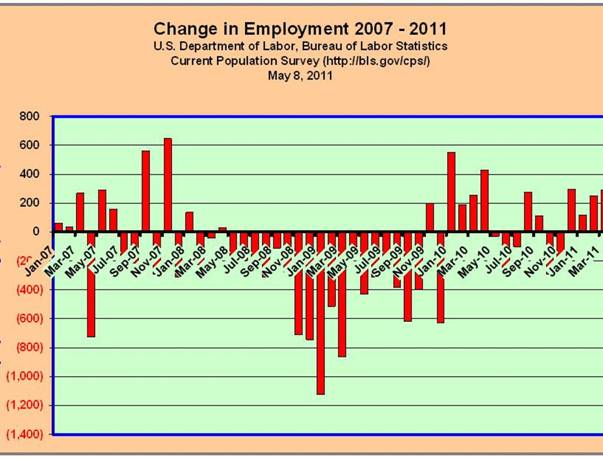
Another look at the the same sad picture

Summary:
Target/Objective
Add 524,000 jobs per month for 24 months (employed)
Composition
- To get from 64.2% Labor Force Participation to 66.2% (average of 66.2% from 2001-2008), 303,000 (part of the above - employed- have to be added or brought back into the Labor Force
- To offset the additional Civilian Noninstitutional Population, we'd have to add 150,000 per month for the new entrants
- The balance of the 524,000 (around 70,000 monthly) would focus on reducing the unemployment rate from the current 9.0% to the 5.3% (the average from 2001-2008)
- The bottom-line is that unless the number is at least 350,000 (new jobs) per month, it is likely that the unemployment will remain the same or rise…due to the encouraged workers pouring in to the Labor Force. Remember that the unemployment rate = Unemployed / Labor Force (labor force = employed + unemployed).
Economic Ideas that Influence Policy Makers
February 16, 2004
Coverage, definitions, and differences between surveys
Household Survey
The sample is selected to reflect the entire civilian noninstitutional population. Based on responses to a series of questions on work and job search activities, each person 16 years and over in a sample household is classified as employed, unemployed, or not in the labor force.
People are classified as employed if they did any work at all as paid employees during the reference week; worked in their own business, profession, or on their own farm; or worked without pay at least 15 hours in a family business or farm. People are also counted as employed if they were temporarily absent from their jobs because of illness, bad weather, vacation, labor-management disputes, or personal reasons.
People are classified as unemployed if they meet all of the following criteria:
They had no employment during the reference week; they were available for work at that time; and they made specific efforts to find employment sometime during the 4-week period ending with the reference week. Persons laid-off from a job and expecting recall need not be looking for work to be counted as unemployed. The unemployment data derived from the household survey in no way depend upon the eligibility for or receipt of unemployment insurance benefits.
The civilian labor force is the sum of employed and unemployed persons. Those not classified as employed or unemployed are not in the labor force. The unemployment rate is the number unemployed as a percent of the labor force. The labor force participation rate is the labor force as a percent of the population, and the employment-population ratio is the employed as a percent of the population.
Establishment Payroll Survey
The sample establishments are drawn from private nonfarm businesses such as factories, offices, and stores, as well as Federal, State, and local government entities. Employees on nonfarm payrolls are those who received pay for any part of the reference pay period, including persons on paid leave. Persons are counted in each job they hold. Hours and earnings data are for private businesses and relate only to production workers in the goods-producing sector and nonsupervisory workers in the service-producing sector.
Differences in employment estimates. The numerous conceptual and methodological differences between the household and establishment surveys result in important distinctions in the employment estimates derived from the surveys. Among these are:
- The household survey includes agricultural workers, the self-employed, unpaid family workers, and private household workers among the employed.
These groups are excluded from the establishment survey.
- The household survey includes people on unpaid leave among the employed. The establishment survey does not.
- The household survey is limited to workers 16 years of age and older.
The establishment survey is not limited by age.
- The household survey has no duplication of individuals, because individuals are counted only once, even if they hold more than one job. In the establishment survey, employees working at more than one job and thus appearing on more than one payroll would be counted separately for each appearance.
Other differences between the two surveys are described in "Comparing Employment Estimates from Household and Payroll Surveys," which may be obtained from BLS upon request.


